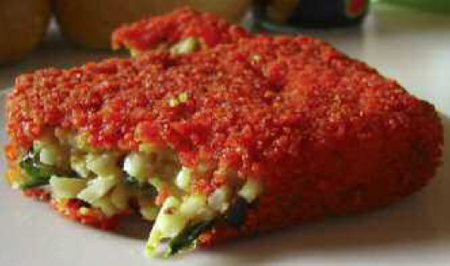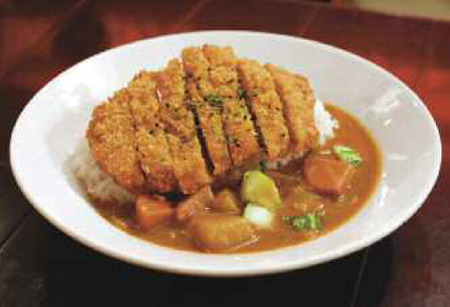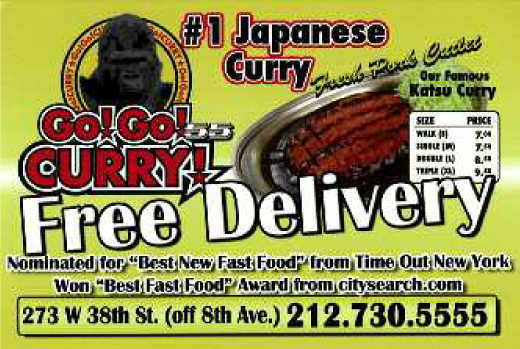7
Other Regions

Give me nasi goreng with a fried egg
Some chilli sauce and some prawn crackers and
a good glass of beer to go with it
Wieteke van Dort, Nasi Goreng
There is scarcely a country in the world whose residents do not enjoy curry. The website www.indiandinner.com lists Indian restaurants and curry houses in more than 90 countries. Curries and Indian dishes are especially popular in Dubai, Doha and other Middle Eastern cities, while Indian and Pakistani restaurants in Saudi Arabia serve pilgrims during the Haj. There are even Indian restaurants in war-torn Kabul that cater to the large number of British and Indian expatriates. However, curry and curry-related dishes enjoy a special position in the former ‘imperial heartlands’, especially the Netherlands and Portugal, as well as in a country that had little connection with India or the mighty imperial powers – Japan.
Europe
The Netherlands’ 350 years as a colonial power have left their mark on its cuisine. As one scholar writes, ‘Dutch taste can broadly be described as having been formed by natives and immigrants . . . It may be viewed as one of the unforeseen consequences of the colonial era.’1 Until the 1950s the main diet of the Dutch consisted of grains, tubers, meat, fish, cheese and butter. Eating was viewed as a necessity rather than as a pleasure; meals were ‘austere, frugally spiced, and repetitive’ and ‘eating out’ was enjoyed only by a small elite.
Although spices were available after the founding of the Dutch East India Company in 1602, they were mainly used by the rich. But after Indonesia won its independence in 1949, more than 200,000 people migrated to the Netherlands, many of them of mixed Dutch and Indonesian origin. Indo-Dutch women began making Indonesian meals in their homes, which were delivered by their husbands to their customers; later they opened small eateries. Indonesian cuisine also appealed to the 100,000 returning Dutch military personnel. An influx of Chinese immigrants opened restaurants serving quasi-Indonesian and Chinese dishes. Grocery shops called tokos opened to sell spices and other Asian ingredients.
In 1950 Dutch women’s magazines began publishing recipes for Chinese and Indonesian dishes. The food industry produced sauces and seasonings for every conceivable dish, and farmers began growing vegetables once considered exotic. In the 1970s people of Dutch nationality started to arrive from Surinam, adding another note to the multicultural melody.
Today, The Hague, Amsterdam and other Dutch cities have many Indonesian restaurants, authentic or otherwise, as well as small establishments that serve a mixture of Surinam, Indonesian and Chinese food. A popular Surinam specialty is roti kip, a chicken curry served with potatoes, eggs, cabbage and Indian-style rotis.
Like Bollywood films, the Indian curries and spices on display in this Iraqi grocery store are popular throughout the Middle East.
Bamihap, a deep-fried snack of noodles coated in breadcrumbs, is served in snack bars and automats in Dutch cities
Snack bars and vending machines serve Indonesian-Chinese-Dutch fusion dishes, including bamischijf (a deep-fried snack of noodles in a breadcrumb crust), nasi balls (deep-fried rice balls with ketchup and sambal), patat sate (fries with satay sauce), bami goreng (fried noodles with seafood, meat, vegetables and sambal) and loempia (spring rolls). Nasi goreng (fried rice) has become a fixture of Dutch domestic cuisine and is sold in frozen or dehydrated versions in supermarkets. However, there is virtually no influence of Sri Lankan or South African cuisine.
The eating patterns of Portugal show traces of its far-flung global empire. Ginger, pepper, turmeric, coriander, cinnamon, fennel, cloves, allspice and chillies (especially the fiery peri-peris from Africa) are used to flavour some dishes, including caldeiras, a fish and vegetable stew. Dashes of curry powder (caril ) are often added to stews and soups in even the remotest country kitchen. Lisbon has a few Goan/Indian restaurants, at least one of which, Sabores de Goa, serves such Goan specialities as carils, chacuti, sorpatel, and xec xec, a crab and coconut curry.
The French were less accepting of the foods of their south Asian empire than the British and the Dutch (perhaps because their own culinary tradition was so strong), and there are virtually no traces in their cuisine of their long association with India, which lasted until 1954.2 The first Indian restaurant in France, Indira, was opened in Paris in 1975 by a member of an Indian government delegation. He was concerned about the absence of Indian restaurants in the city. Indian restaurants there are far outnumbered by establishments serving North African and Vietnamese food. The first published curry recipe was given by the pioneering restaurateur Antoine Beauvilliers in his L’Art de cuisiner (1814). At the University of Paris Exhibition of 1889, the composition of curry powder was established by government decree: 34 grams of tamarind, 44 grams of onion, 20 grams of coriander, 5 grams of chilli, 3 grams each of turmeric and fenugreek, 3 grams of cumin and 1 gram of mustard seed. These are typical components of a south Indian curry powder. Recipes for chicken curry (cari de poulet) in various editions of Larousse gastronomique are an almost surrealistic merger of elements of French, British and Indian cuisine. The onions are sautéed with ham, apples, garlic, thyme, bay leaves, cinnamon, cardamom and powdered mace. Curry powder is then simmered with tomatoes and almond or coconut milk and the dish is finished with a dollop of heavy cream.
A plaque marks the spot where Berliners claim that currywurst was invented in 1949. |
Currywurst, grilled pork sausage sprinkled with curry powder and topped with tomato ketchup.
In Germany, the most popular street and fast-food dish is currywurst – a finely grained pork sausage roasted on skewers with onions and green peppers, cut into bite-sized pieces, sprinkled with curry powder and topped with tomato ketchup. It is prepared mit or ohne – with or without skin – and scharf or extra scharf – hot or extra hot. It is usually served with fries topped with ketchup, mayonnaise or both. This dish may have originated in the Dutch patat satay.
Almost a billion currywursts are consumed in Germany every year, and a recent study indicated that eighty per cent of Germans consider the dish a central part of their diet. The dish is so dear to the German heart that a fight has emerged over its origins. Berliners claim that it was invented in 1949 by Herta Heuwer, owner of a snack bar the site of which is now marked with a plaque. But residents of Hamburg claim it was first made in their city in 1947 by Lena Brucker, the central character in a 1993 novel by Uwe Timm, Die Entdeckung der Currywurst (The Discovery of Currywurst), which has since been made into a film.
Curry and rice is one of the most popular dishes in Japan and a favourite of Japanese schoolchildren.
Indian spices have been used in Scandinavian cuisine for hundreds of years, thanks to the region’s thriving shipping trade. Curried herring or mackerel on toast is a popular dish.
Japan
In a survey conducted in the early 1980s, the Japanese named curry and rice (kare raisu3) as one of their favourite three home-cooked dishes (the others were pork cutlets and vegetable stir-fry), while Japanese schoolchildren voted it the best meal served for school lunch. In Japan, there is a saying that you are never more than five minutes away from a curry shop. (For authentic Indian food, you have to go to an indo-ryori restaurant.)
From 2001 to 2007 there was even a curry museum in Yokohama, a sort of curry theme park featuring hostesses wearing saris, exhibits on the history of curry and spices, and a food court that served an array of curries and dishes made with curry powder, including Okinawan curry made with sake, an omelette-rice curry, a curry cocktail and curry chocolate.
A Japanese curry is a distinctive dish. It consists of chunks of meat (usually chicken, beef and shrimp), carrots, onions and potatoes simmered in an ochre-coloured, curry-powder-flavoured, slightly sweetish sauce. The sweetness comes from apples or honey. Often a fried pork cutlet (tonkatsu) is placed on top. The rice and curry are served separately on a Western-style plate, to be mixed later, and are eaten with a spoon. Pickled vegetables or ginger, an essential component of a Japanese meal, are served on the side.
In many ways, curry is the antithesis of Japanese food, which is based on the principle that ingredients should retain their natural appearance and taste. Japanese food historian Elizabeth Andoh recalls her disgust at her first encounter with ‘dreadful curry rice with a terrible smell which nauseated me’.4 But there are many reasons for curry’s popularity. Housewives like it because it is convenient, inexpensive and easy to make in microwave ovens. It is the Japanese version of comfort food with no pretensions to class or elegance. It is never served in upmarket restaurants, at parties or receptions, or to guests, but, as Japanese food expert Richard Hosking writes, ‘Schoolboys love it and anyone planning a summer camp or a winter skiing holiday would be making a great mistake not to include it at least once on the menus.’5 The spiciness of curry offers a welcome contrast to the blandness of traditional Japanese food.
Curry Man is the name of a popular American wrestler in Japan. He wears a plastic dish of curry as a helmet and his repertoire of moves includes the spice rack and the spicy drop. |
The curry flavour comes from either powder or from a ready-made roux – a block of spices and flour suspended in animal fat. Scored for easy separation, these blocks range from mild to very hot. The most popular brands are S&B Foods Inc. (the name is a variation on C&B, standing for Crosse and Blackwell) and House Foods Corporation – multi-billion-dollar international companies founded in the 1920s. House Foods produced the first block of curry roux in 1960. A few years later it launched a line of roux with the odd name Vermont Curry (perhaps because it contains apples), a milder, sweeter version designed to appeal to children. The 1970s saw the creation of the hermetically sealed pouch that can hold foods without refrigeration and be reheated in boiling water. Today these bags account for 40 per cent of packaged curry sales. Unlike British curries, which sometimes use left-overs, Japanese curries are usually made from fresh meat.
Curry came to Japan in 1868 at the beginning of the Meiji Era (1868–1912), when Japanese ports were again opened to foreigners. (In the late sixteenth century, Portuguese traders and missionaries entered Japan and were sequestered for more than two hundred years in a small trading post near Nagasaki. They introduced stews, pastries, bread and fried foods such as tempura and cutlets.) Small communities of English merchants in Kobe and other cities brought manufactured curry powders. Articles in women’s magazines and recipe books taught housewives how to make curry, and its popularity spread quickly. A Japanese cookbook, Seiyo Ryori Tsu (The Western Cooking Expert, 1872), describes a curry stew very similar to the curried chicken recipe in Mrs Beeton’s cookbook of 1861.
There were several reasons why curry caught on in Japan. One was a fascination for all things Western during the Meiji and Tasho eras (1912–26). Curry belongs to a category of foods called yoshoku, Western dishes adapted to local tastes. These dishes also used ingredients such as potatoes, tomatoes, onions, eggs, chicken, beef, pork and butter that were not commonly used in Japanese cooking. The military wanted to encourage meat consumption as a way of building up the physiques of Japanese youth and found curry-rice an ideal way to incorporate vegetables, rice and meat in one inexpensive substantial meal. The Emperor Meiji told everyone to start eating meat (which had been discouraged by Buddhism) and ate it himself.
Japanese curry chains such as GoGo Curry have opened branches around the world. This menu from the New York restaurant offers special incentives for people who can eat super-hot dishes.
Curry became a staple of menus of Japanese steamships travelling to Europe. In 1930 a merchant who had tried curry rice on board put it on the menu of the cafeteria in his department store in Osaka, where it became the best-selling dish. Curry houses were soon opened throughout the country. Today Japanese chains have branches in the United States such as Curry House, Coco Ichibanya and GoGo Curry. The Honolulu branch of Curry House features cheese, banana, hotdog, fried chicken and squid curries. They are available in seven levels of ‘hotness’ and with different quantities of rice up to a 1,300-gram serving that is free for anyone who can eat it in twenty minutes.
In 2007 GoGo Curry opened its first American branch in New York City. It is a kind of shrine to New York Yankees star Hideki Matsui. (GoGo means 55 in Japanese, Matsui’s number when he played for the Yomiuri Giants.) The restaurant offers 55 cents off any entrée on days that Matsui hits a home run. Rice is served in five different-sized portions: walk, single, double, triple and grand slam.
A popular Japanese fast food is curry bread (kare pan): curry wrapped in a piece of dough dipped in breadcrumbs (panko) and deep fried. A character named kare pan man, whose head is made of curry bread, is one of the super-heroes in Anpanman, one of the most popular Japanese anime cartoon series.
Curry is also a popular home-made dish in Korea. It is usually made Japanese-style from ready-made mixes.






